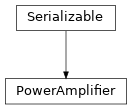Amplification¶

Amplifcation modeling represents a single processing step within the radio-frequency hardware model of simulated devices. Amplifier models implement an equation
distorting complex-valued signal samples \(s(t) \in \mathbb{C}\) feeding into the power amplifier. For time-invariant (i.e. memoryless) models \(f\lbrace s(t), t \rbrace = f\lbrace s(t) \rbrace\).
The currently available amplifier models are
Amplification Model |
Description |
|---|---|
Model of a power amplifier driven into saturation. |
|
Power amplification model with fully customizable gain characteristics. |
|
Ideal power amplifier model. HermesPy’s default configuration. |
|
Power amplification model following Rapp[1]. |
|
Power amplification model following Saleh[2]. |
Configuring a SimulatedDevice's amplification
requires setting the phase_noise property
of the device’s rf_chain:
1# Create a new device
2simulation = Simulation()
3device = simulation.new_device()
4
5# Configure the device's default amplification model
6device.rf_chain.power_amplifier = PowerAmplifier()
Of course, the abstract PowerAmplifier model in the above snippet has to be replaced by one the implementations listed above. The following figure visualizes the gain characteristics for the implemented amplification models for a saturation point \(s_\mathrm{sat} = 1\).
(Source code, png, hires.png, pdf)
